The Performance and Feasibility of Solar-Powered Desalination for Brackish Groundwater in Egypt
Abstract
1. Introduction
| No | Region | Desalination Capacity (m3/day) |
|---|---|---|
| 1 | Red Sea | 242,000 |
| 2 | Marsa Matruh | 150,000 |
| 3 | North Saini | 120,000 |
| 4 | South Saini | 121,000 |
| Total | 633,000 | |
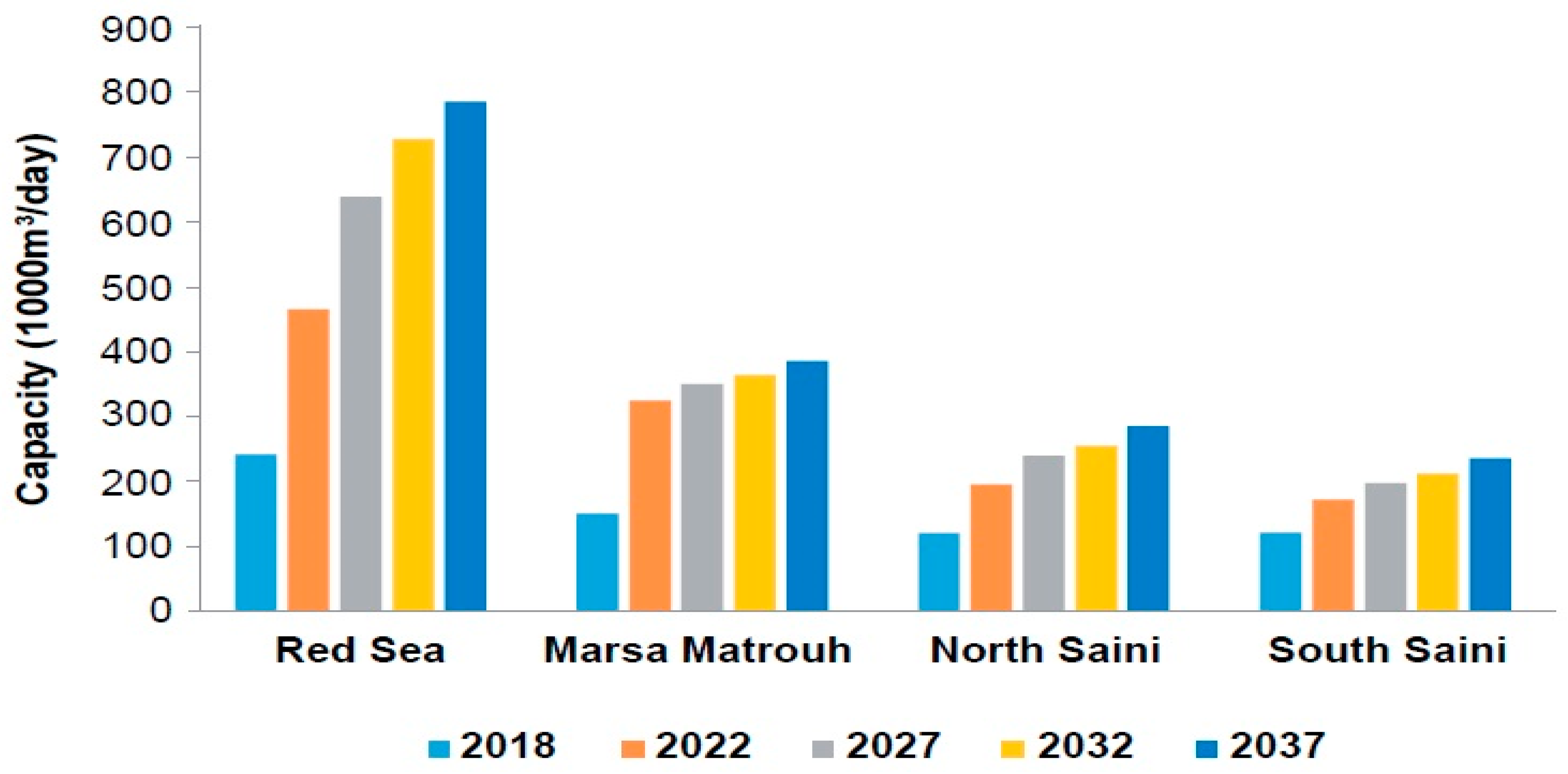
2. Materials and Method
2.1. Site Selection Criteria Using GIS
- (a)
- Solar Radiation (Kwhr/m2/day)
- (b) Wind Speed (m/s)
- (c) Temperature (°C)
- (d) Depth to Groundwater Levels
- (e) Groundwater Quality (Salinity)
2.2. Exclusion Areas
2.3. Pilot Project Site Selection
2.4. Solar Desalination Pilot Plant at El Alamein
3. Results and Discussion
3.1. The Feed Water Flow, Quality, and Temperature
3.2. The Permeate Flow and Quality
3.3. Energy Consumption
3.4. RO System Recovery
3.5. The Economic Analysis for the System
3.6. Assessment of the Performance of Solar Desalination Systems
3.7. Environmental Impacts Analysis
4. Conclusions and Recommendations
Author Contributions
Funding
Institutional Review Board Statement
Informed Consent Statement
Data Availability Statement
Conflicts of Interest
References
- Abdel-Shafy, H.; Mansour, M. Overview on Water Reuse in Egypt: Present and Future: Use of treated wastewater is oftremendous potential importance to Egypt, particularly for restricted irrigation and forest trees. Sustainable Sanitation Practice. 2013, pp. 17–25. Available online: http://www.ecosan.at/ssp/selected-contributions-from-the-1st-waterbiotech-conference-9-11-oct-2012-cairo-egypt/SSP-14_Jan2013_17-25.pdf (accessed on 25 November 2023).
- Dawoud, M. Egypt’s Non-Conventional Water Resources: Desalination Sector Analysis and Proposed Development; African Development Bank Report; African Development Bank: Cairo, Egypt, 2019; p. 97. [Google Scholar]
- Ministry of Water Resources and Irrigation (MWRI). Egyptian National Water Resources Plan; Ministry of Water Resources and Irrigation: Cairo, Egypt, 2023; p. 125.
- El-Rawy, M.; Mostafa, A.A.; Hashe, D.; Eltarabily, M.G. Groundwater management of quaternary aquifer of the Nile Valley under different recharge and discharge scenarios: A case study Assiut governorate, Egypt. Ain Shams Eng. J. 2021, 12, 2563–2574. [Google Scholar] [CrossRef]
- Central Agency for Public Mobilization and Statistics. Egypt Future Population Projections (2017–2052); Central Agency for Public Mobilization and Statistics: Cairo, Egypt, 2017.
- Abd El-Hady, B.; Kashyout, A.H.; Gasser, H.; Hassan El-Banna, F.; Abd El-Wahab, K.; Hisham, E.; Ranjan, V.; Mohammad, H.S. Hybrid renewable energy/hybrid desalination potentials for remote areas: Selected cases studied in Egypt. RSC Adv. 2021, 11, 13201–13219. [Google Scholar]
- Dawoud, M.; Alaswad, S.O.; Ewea Hatem, A.; Dawoud, R.M. Towards sustainable desalination industry in Arab region: Challenges and opportunities. Desalination Water Treat. 2020, 193, 1–10. [Google Scholar] [CrossRef]
- El-Sadek, A. An imperative measure for water security in Egypt. Desalination 2010, 250, 876–884. [Google Scholar] [CrossRef]
- de Doile, G.N.D.; Rotella, P., Jr.; Rocha, L.C.S.; Bolis, I.; Janda, K.; Coelho, L.M., Jr. Hybrid Wind and Solar Photovoltaic Generation with Energy Storage Systems: A Systematic Literature Review and Contributions to Technical and Economic Regulations. Energies 2021, 14, 6521. [Google Scholar] [CrossRef]
- Al-Sarihi, A.; Mansouri, N. Renewable energy development in the gulf cooperation council countries: Status, barriers, and policy options. Energies 2022, 15, 1923. [Google Scholar] [CrossRef]
- Onishi, V.C.; Khoshgoftar, M.H.; Salcedo-Díaz, R.; Ruiz-Femenia, R.; Labarta, J.A.; Caballero, J.A. Thermo-economic and environmental optimization of a solar-driven zero-liquid discharge system for shale gas wastewater desalination. Desalination 2021, 511, 115098. [Google Scholar] [CrossRef]
- Meng, Y.; Tang, D.; Xu, H.; Li, Y.; Gao, L. Coalbed methane produced water in China: Status and environmental issues. Environ. Sci. Pollut. Res. 2014, 21, 6964–6974. [Google Scholar] [CrossRef] [PubMed]
- Goosen, M.; Mahmoudi, H.; Alyousef, Y.; Ghaffour, N. Solar desalination: A review of recent developments in environmental, regulatory and economic issues. Sol. Compass 2023, 5, 100034. [Google Scholar] [CrossRef]
- Ibrahim, S.M.A.; Shabak, A.G.M. Design of a Solar Powered Reverse Osmosis System in Egypt. J. Mech. Energy Eng. 2021, 5, 125–140. [Google Scholar] [CrossRef]
- Abo Zaid, D.E. Economic analysis of a stand-alone reverse osmosis desalination unit powered by photovoltaic for possible application in the northwest coast of Egypt. Desalination Water Treat. 2014, 54, 3211–3217. [Google Scholar] [CrossRef]
- Eltawil, M.A.; Zhao, Z.; Yuan, L. A review of renewable energy technologies integrated with desalination systems. Renew. Sustain. Energy Rev. 2009, 13, 2245–2262. [Google Scholar] [CrossRef]
- Moharram, N.A.; Tarek, A.; Gaber, M.; Bayoumi, S. Brief review on Egypt’s renewable energy current status and future vision. Energy Rep. 2022, 8, 165–172. [Google Scholar] [CrossRef]
- Gebaly, A.M.; Nashwan, M.S.; Khadr, W.M.; Shahid, S. Future changes in wind energy resources in Egypt under Paris climate agreements’ goals. Reg. Environ. Chang. 2023, 23, 63. [Google Scholar] [CrossRef]
- Abou-Ali, H.; Elayouty, A.; Mohieldin, M. Chapter 3|Climate Action in Egypt: Challenges and Opportunities in Keys to Climate Action; Working Paper No. (180.3); Center for Sustainable Development Columbia University: New York, NY, USA, 2023; pp. 1–28. [Google Scholar]
- Elkholy, M. Assessment of Water Resources in Egypt: Current Status and Future Plan. In Groundwater in Egypt’s Deserts; Elkhouly, A.N.A., Ed.; Springer: Berlin/Heidelberg, Germany, 2021; pp. 395–425. [Google Scholar]
- Sallam, F.T.; Sadek, M.A.; Rayan, R.A.; El-Shahat, M.F. Sources of Salinity and Suitability for Irrigation and Drinking Use of the Groundwater of Northwest of ElMinia, Upper Egypt. Egypt. J. Chem. 2020, 63, 4063–4074. [Google Scholar] [CrossRef]
- Khatib, T.; Mohamed, A.; Sopian, K.; Mahmoud, M. A New Approach for Optimal Sizing of Standalone Photovoltaic Systems. Int. J. Photoenergy 2012, 2012, 391213. [Google Scholar] [CrossRef]
- Nghiem, L.D.; Schäfer, A.I. Critical risk points of nanofiltration and reverse osmosis processes in water recycling applications. Desalination 2006, 187, 303–312. [Google Scholar] [CrossRef]
- Simon, T.W.; Price, W.E.; Nghiem, L.D. Sodium hydroxide production from sodium carbonate and bicarbonate solutions using membrane electrolysis: A feasibility study. Sep. Purif. Technol. 2014, 127, 70–76. [Google Scholar] [CrossRef]
- Melián-Martel, N.; Sadhwani, J.J.; Ovidio Pérez Báez, S. Saline waste disposal reuse for desalination plants for the chloralkali industry: The particular case of pozo izquierdo SWRO desalination plant. Desalination 2011, 281, 35–41. [Google Scholar] [CrossRef]
- Elsaie, Y.; Ismail, S.; Soussa, H.; Gado, M.; Balah, A. Water desalination in Egypt; literature review and assessment. Ain Shams Eng. J. 2023, 14, 101998. [Google Scholar] [CrossRef]
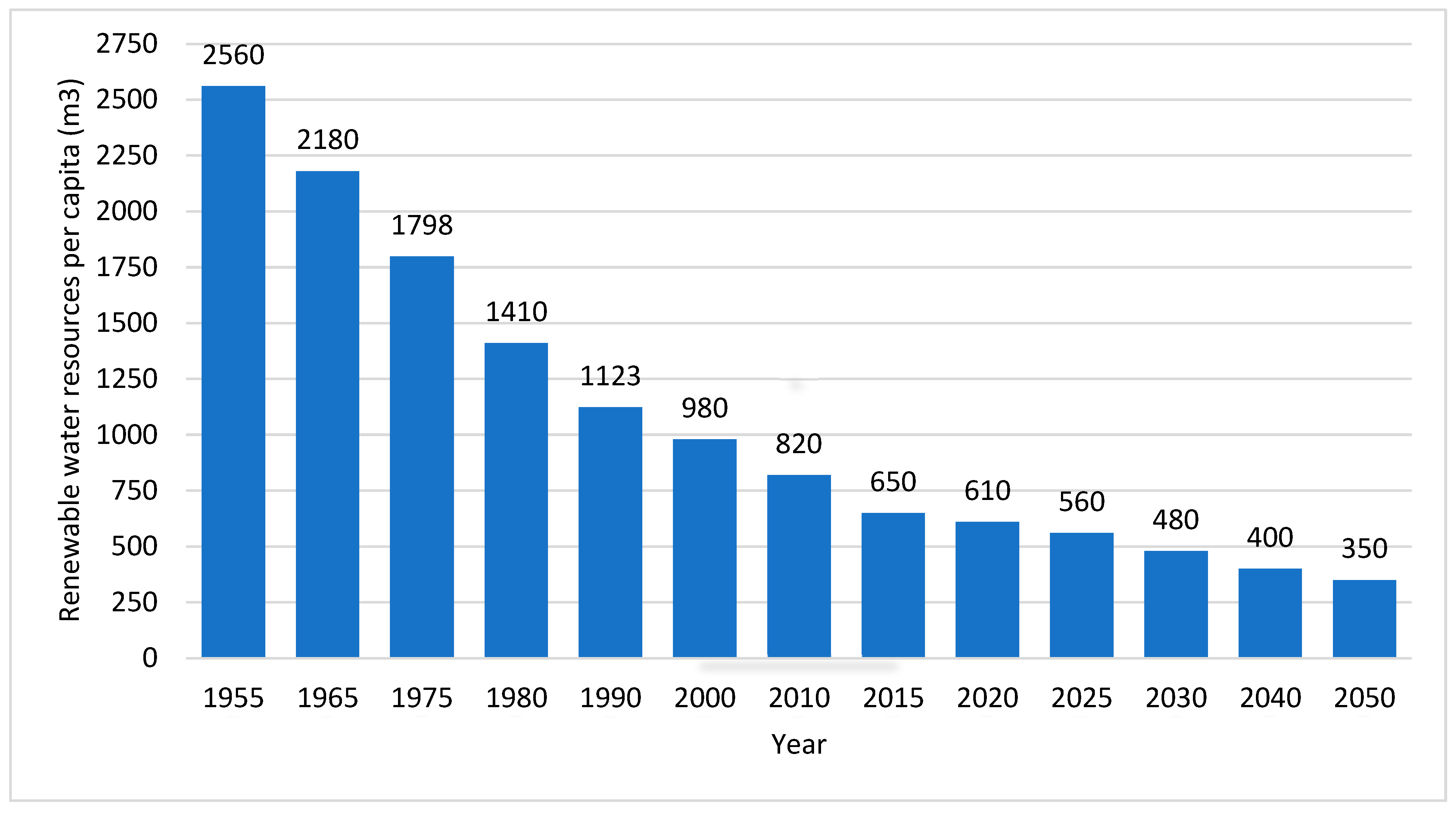
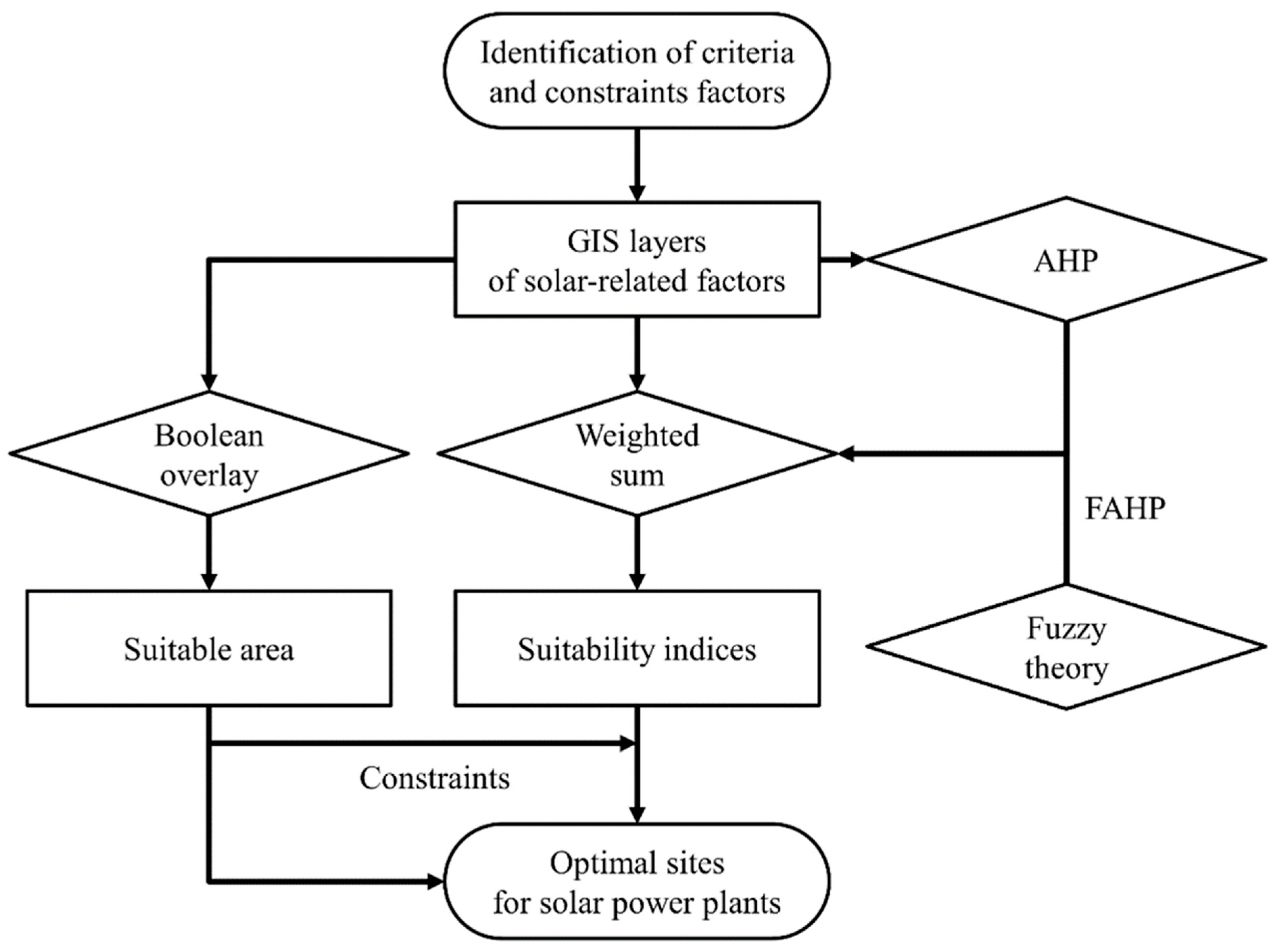
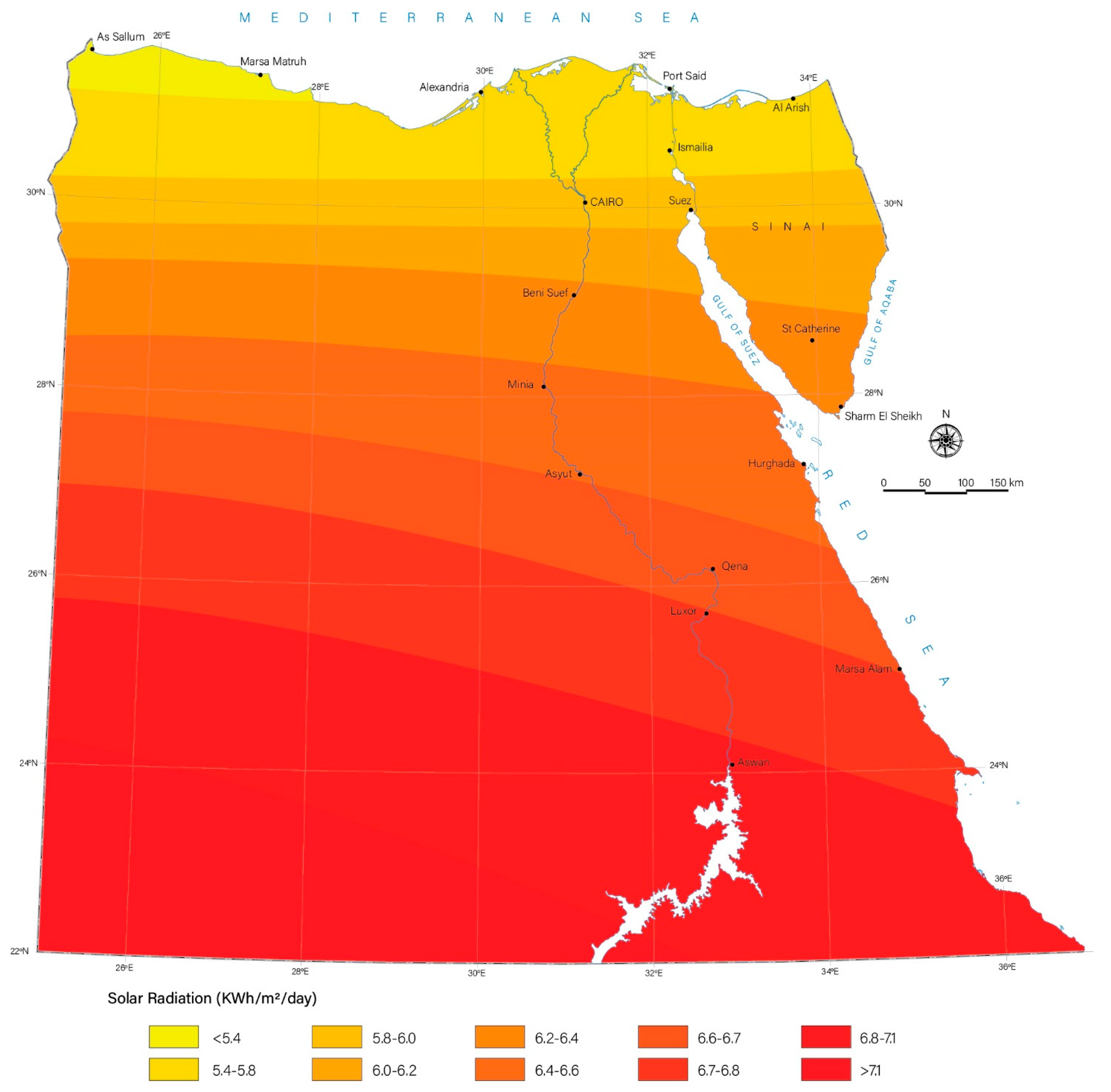
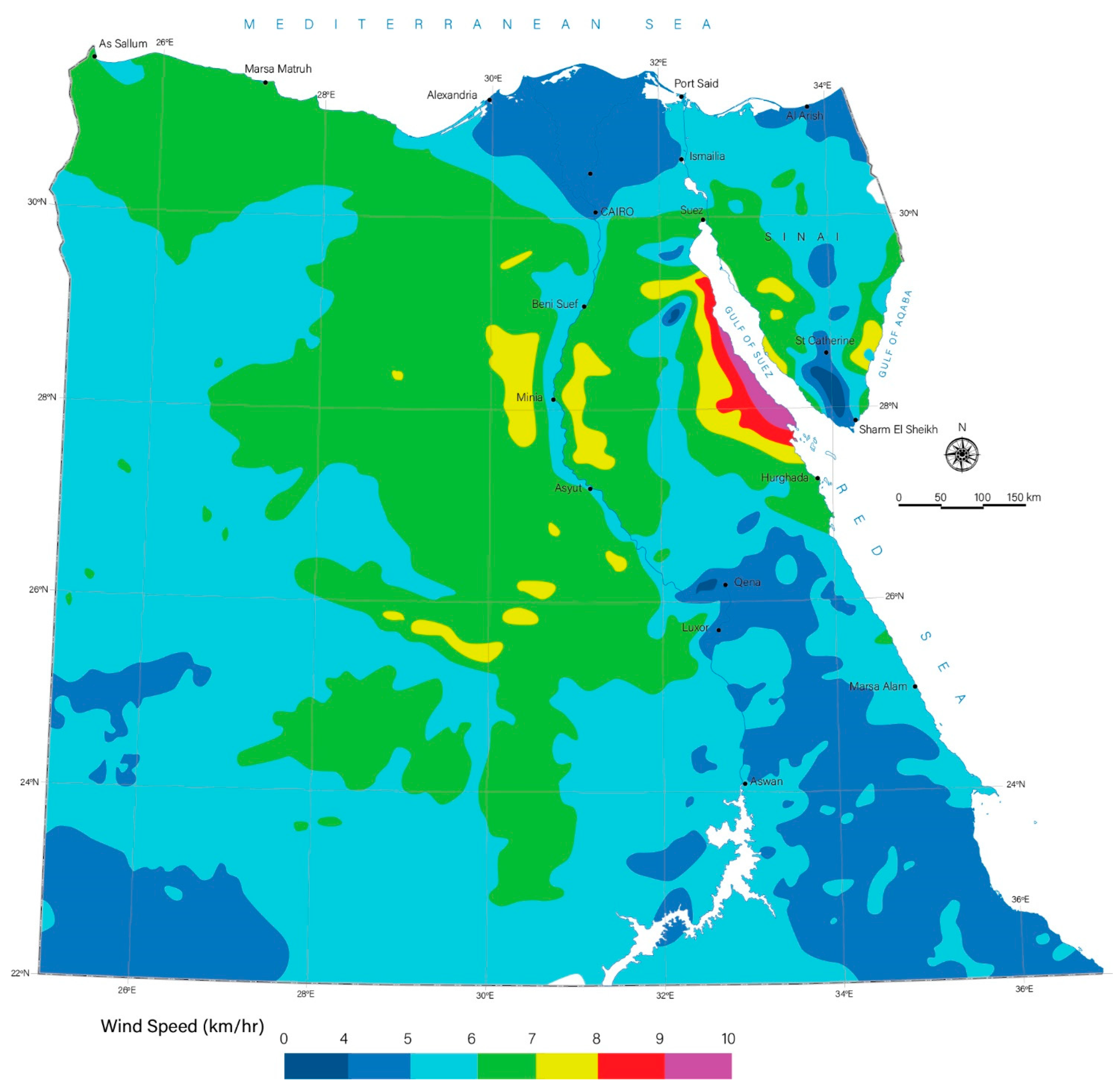
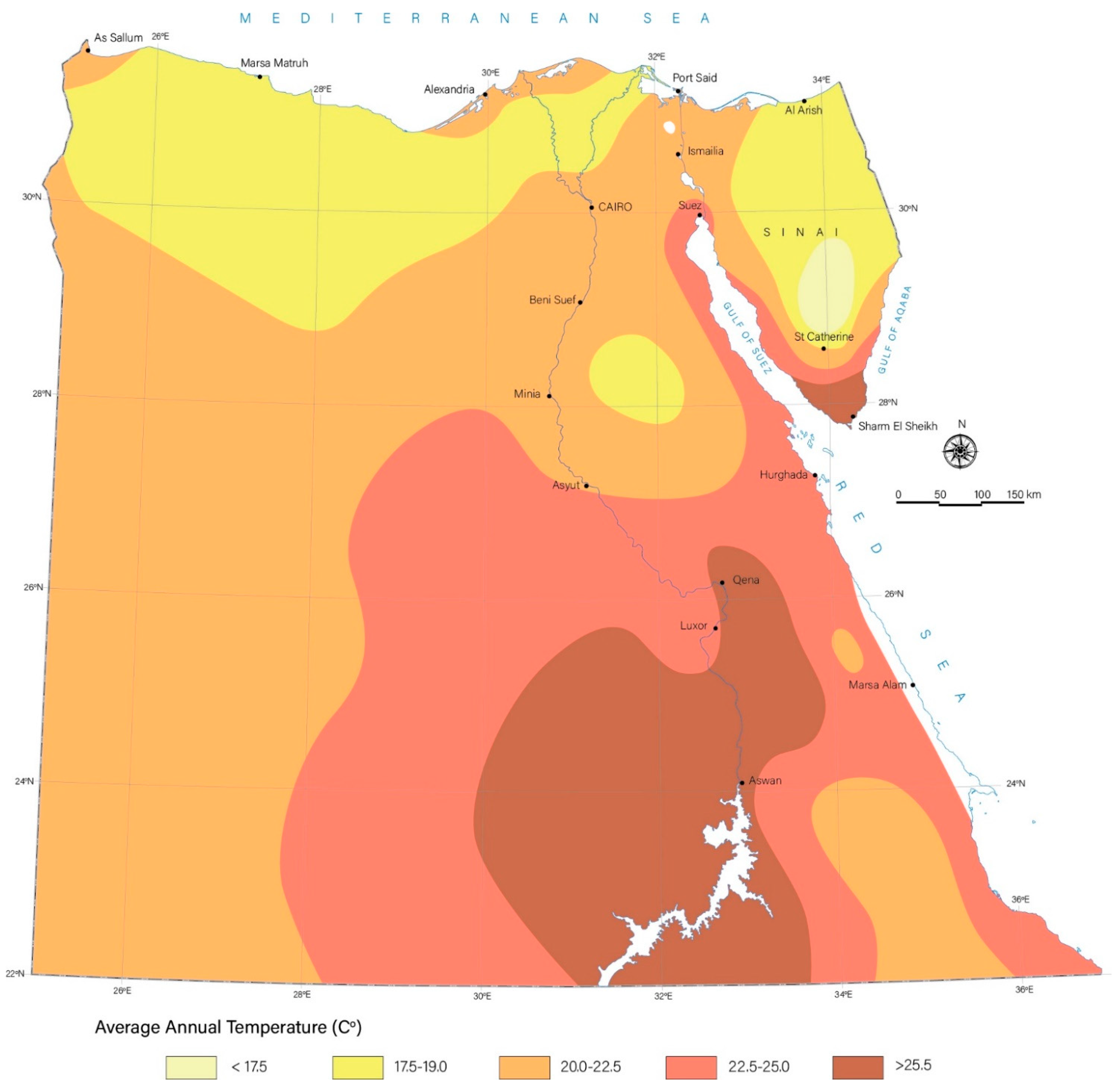
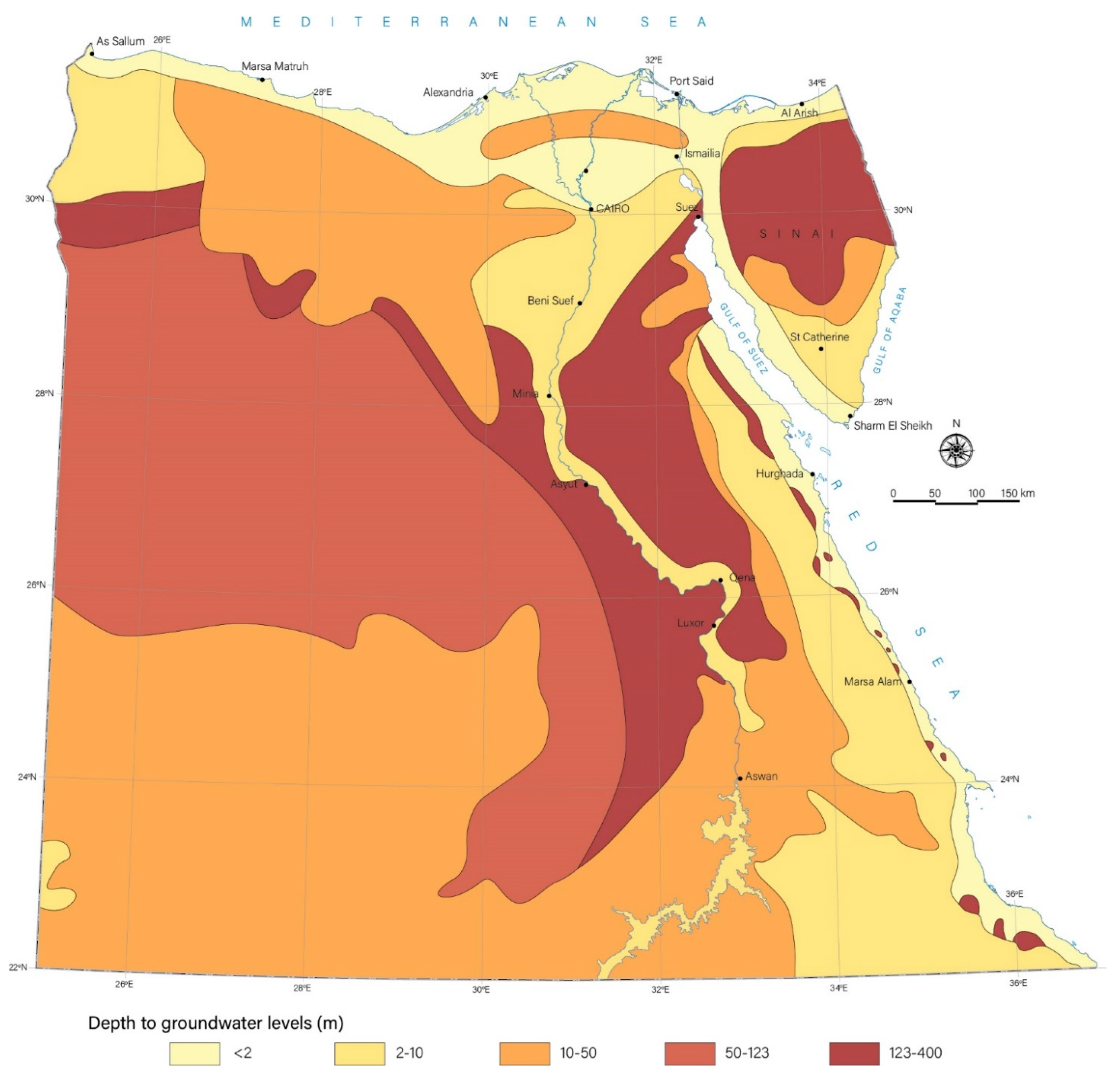
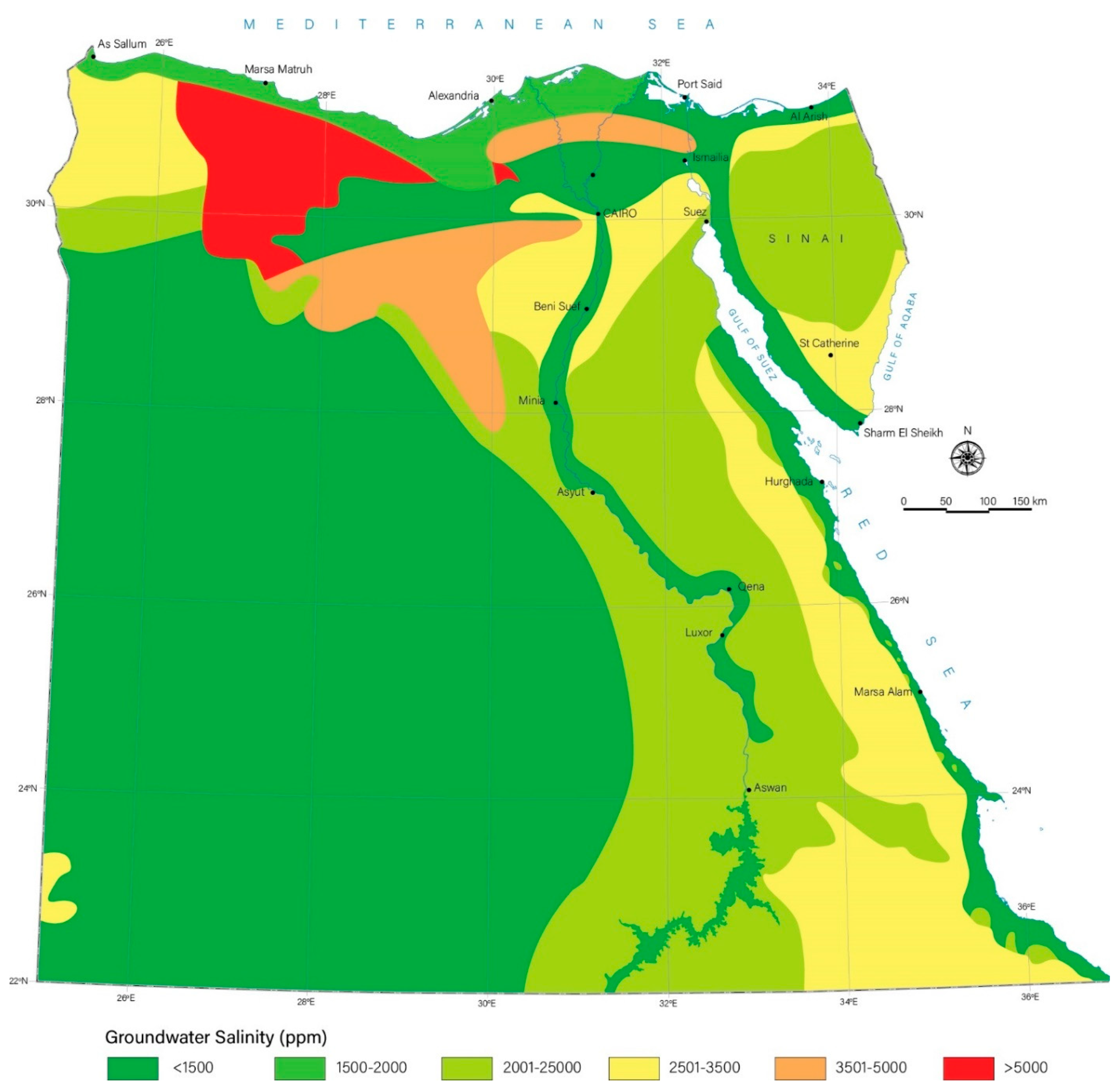
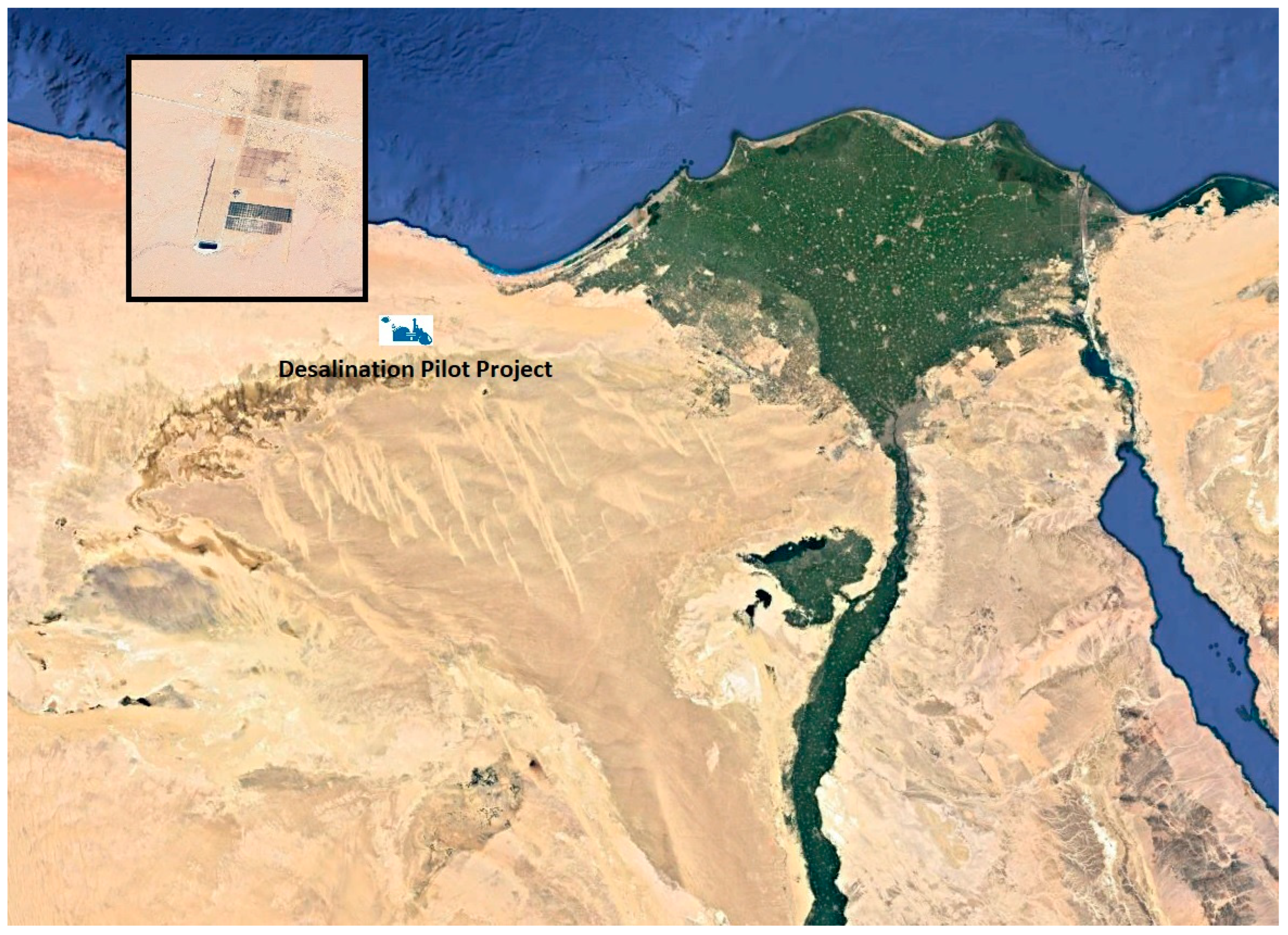
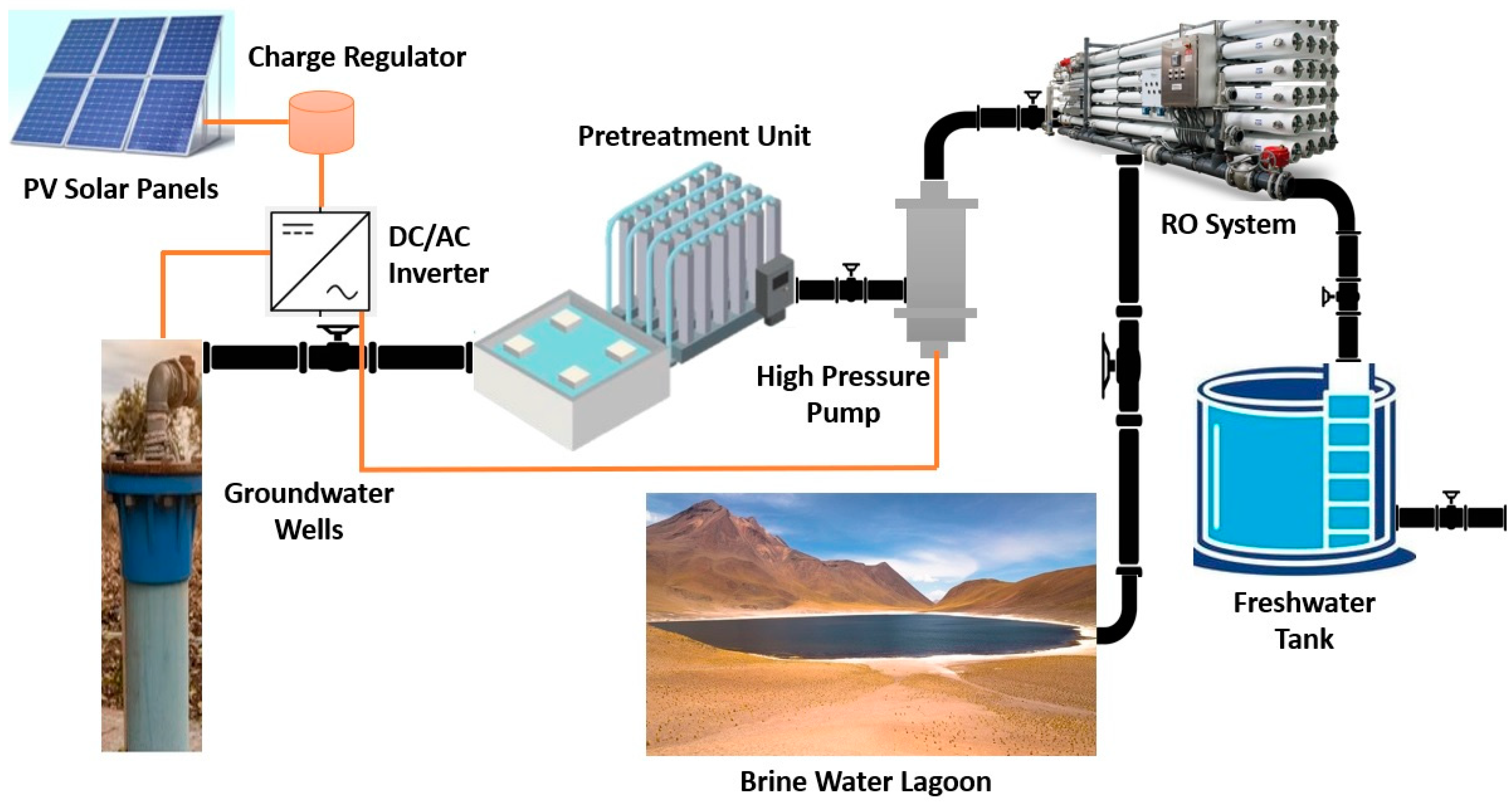
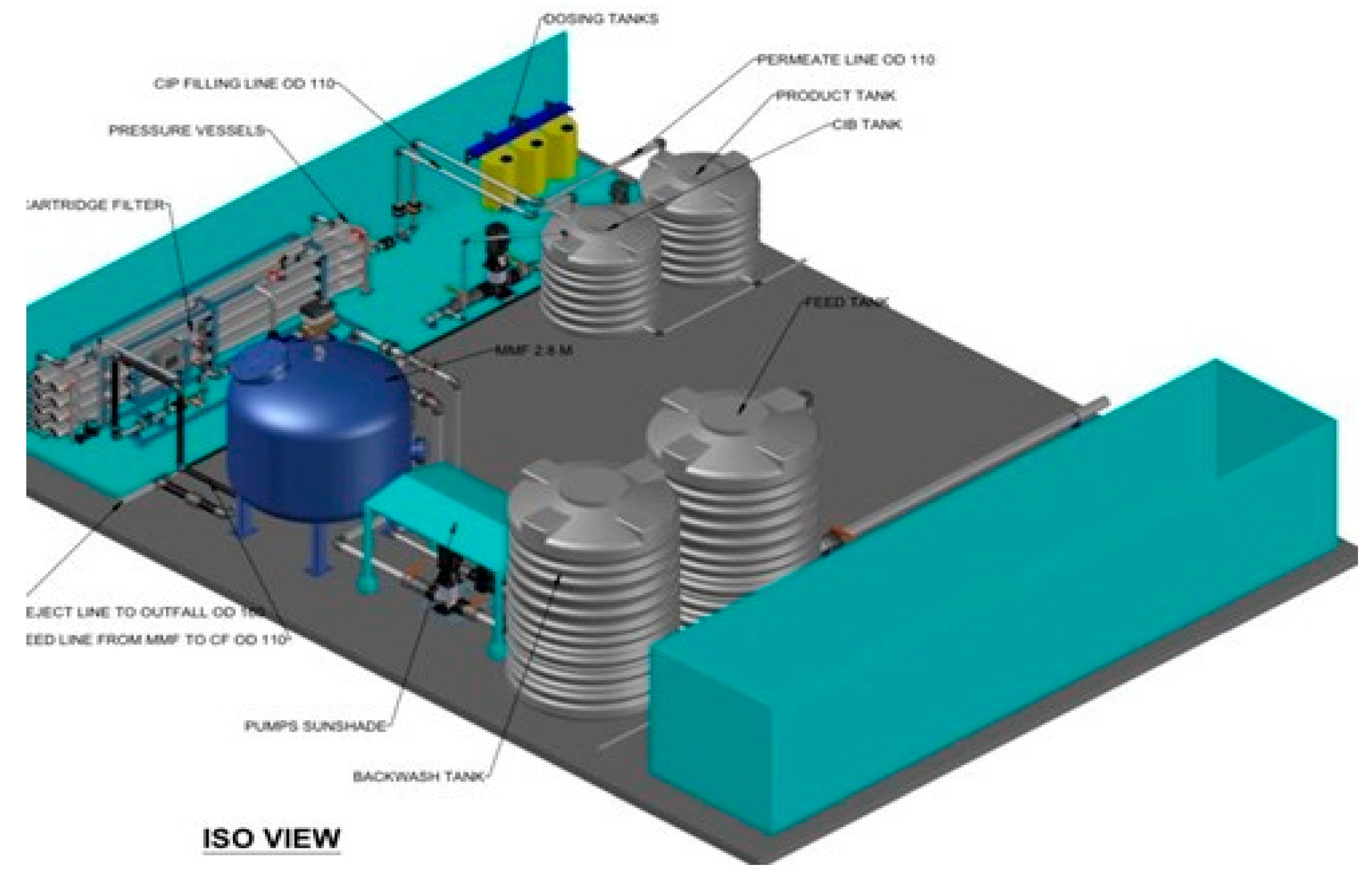
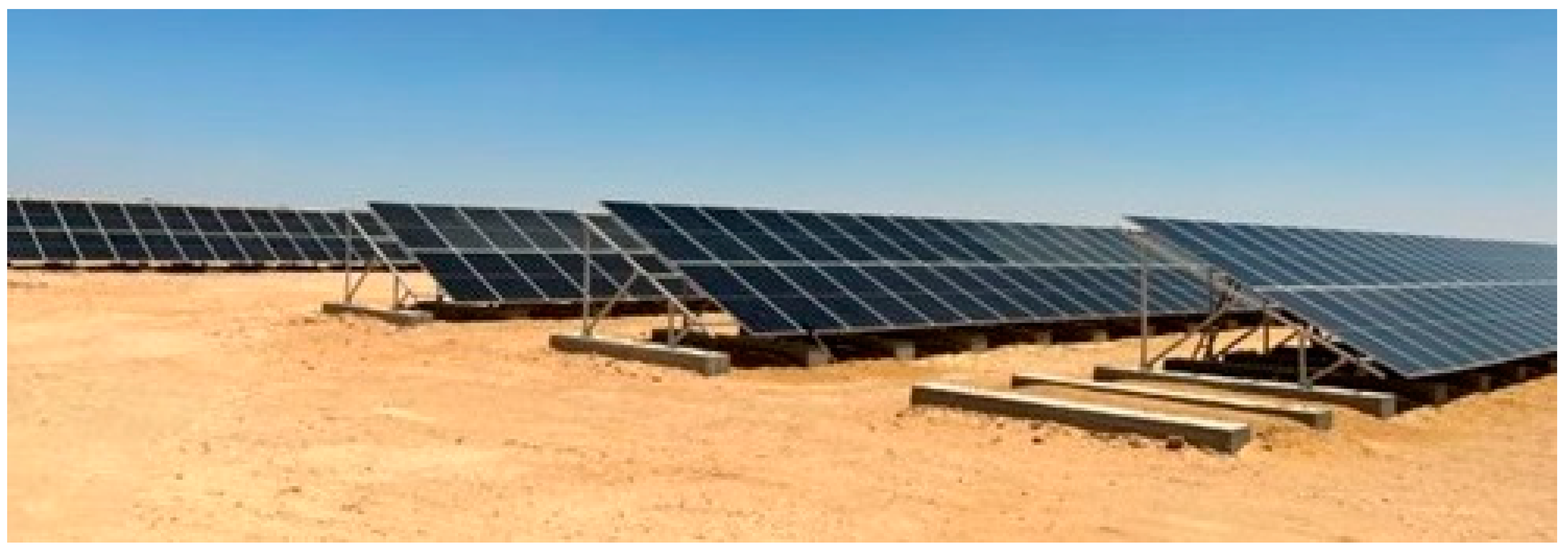
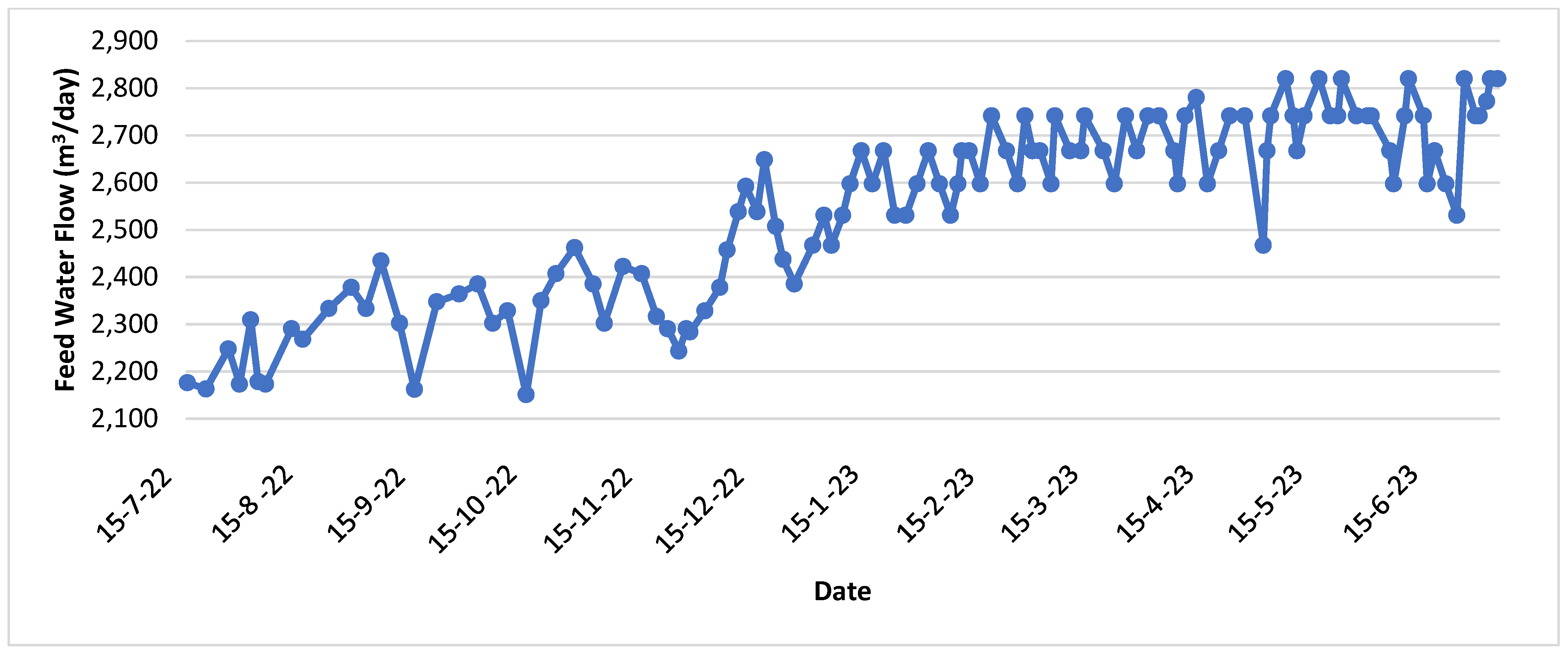
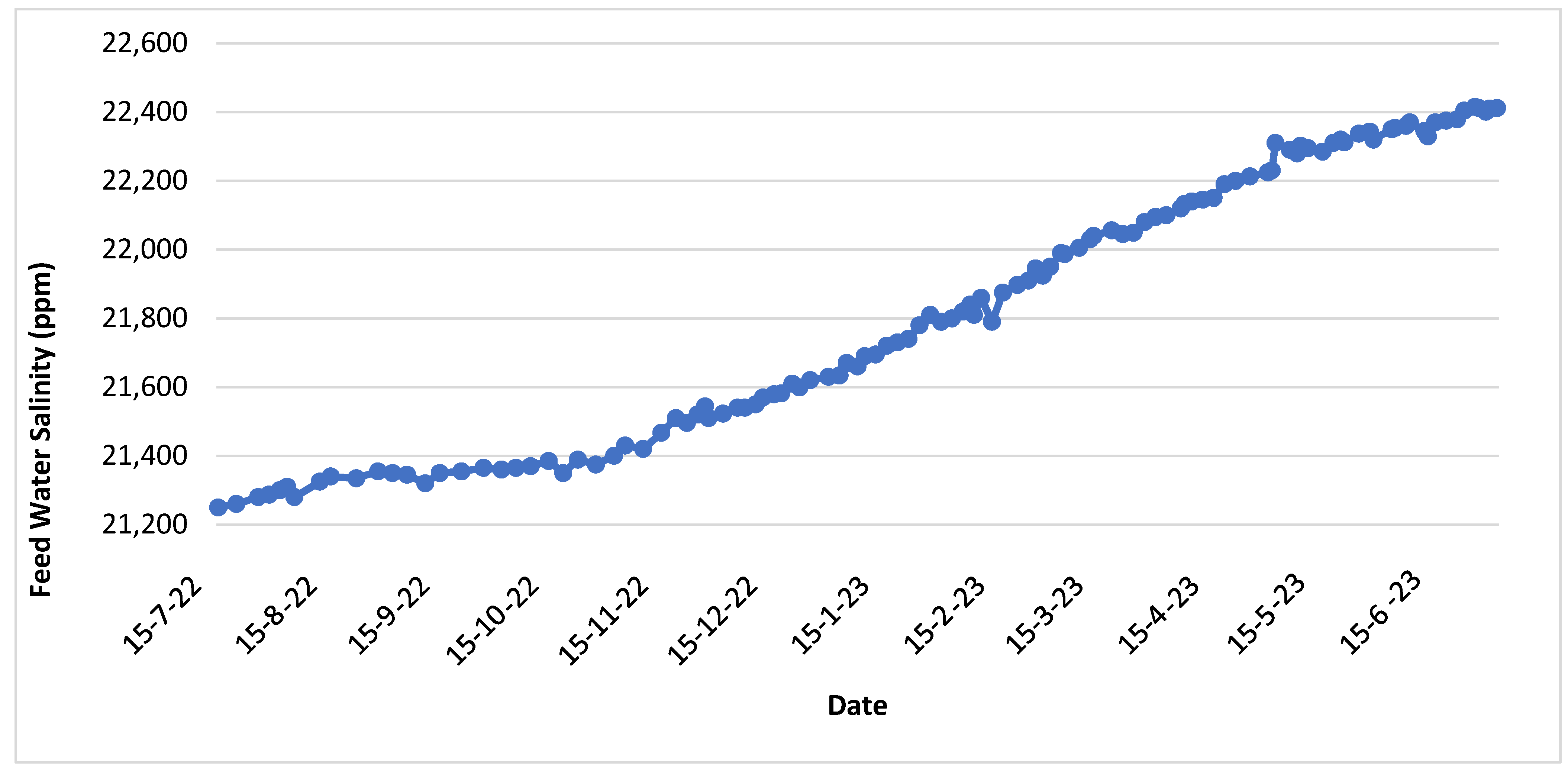
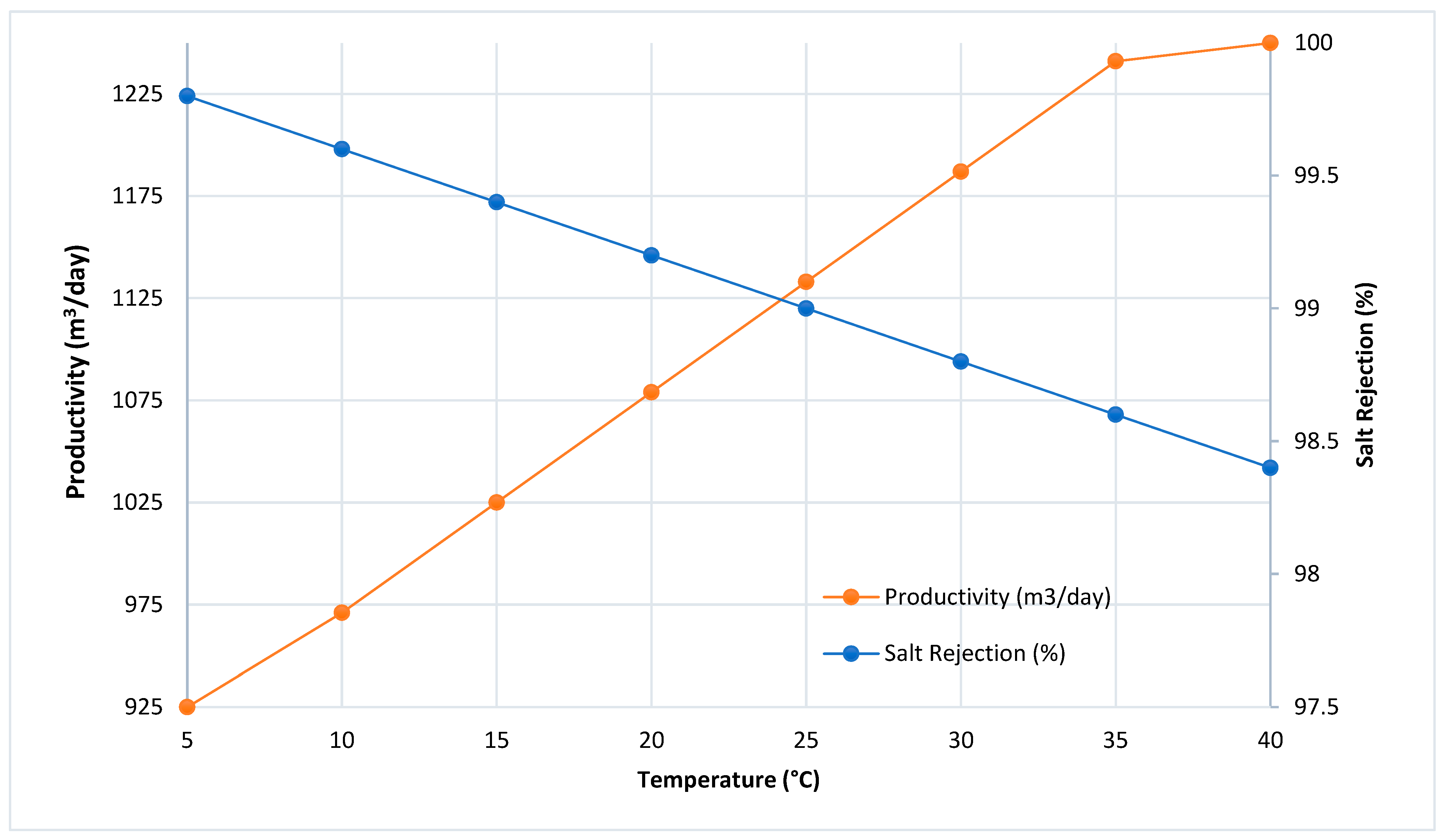
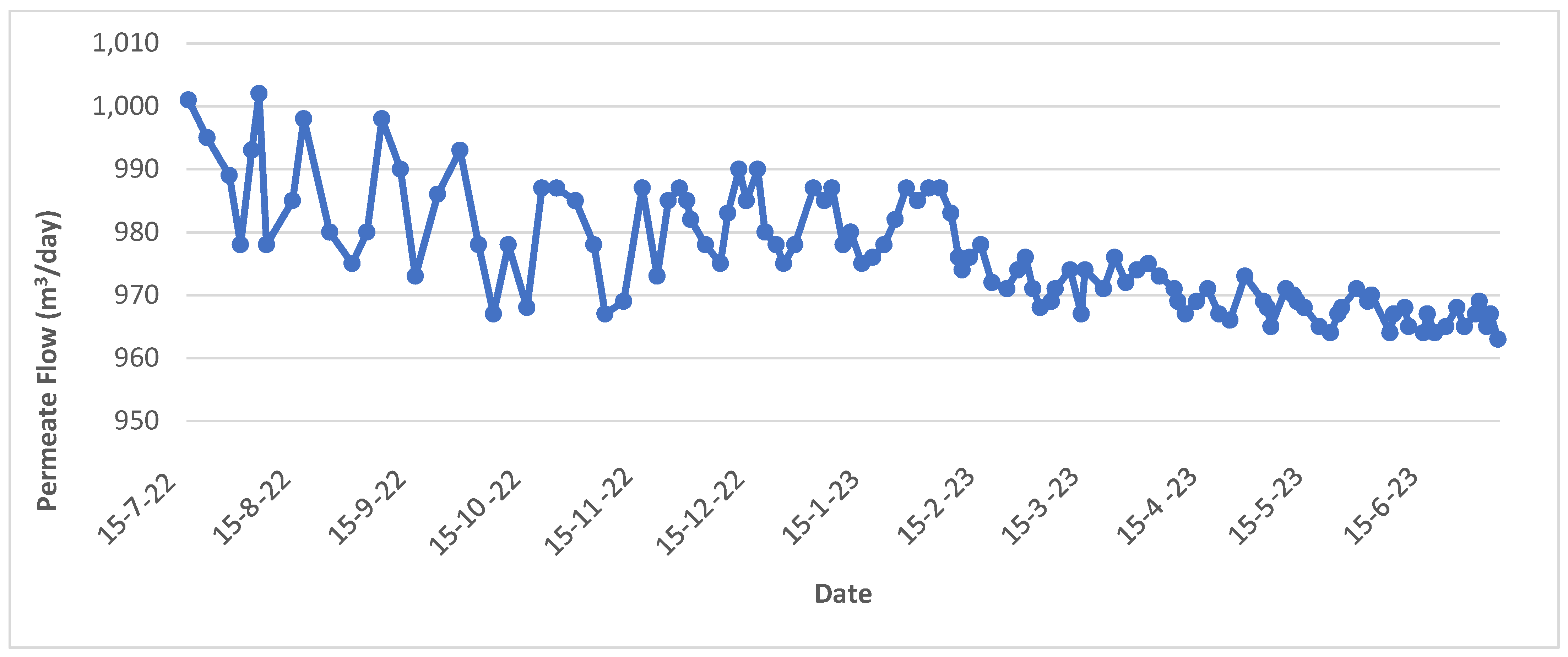
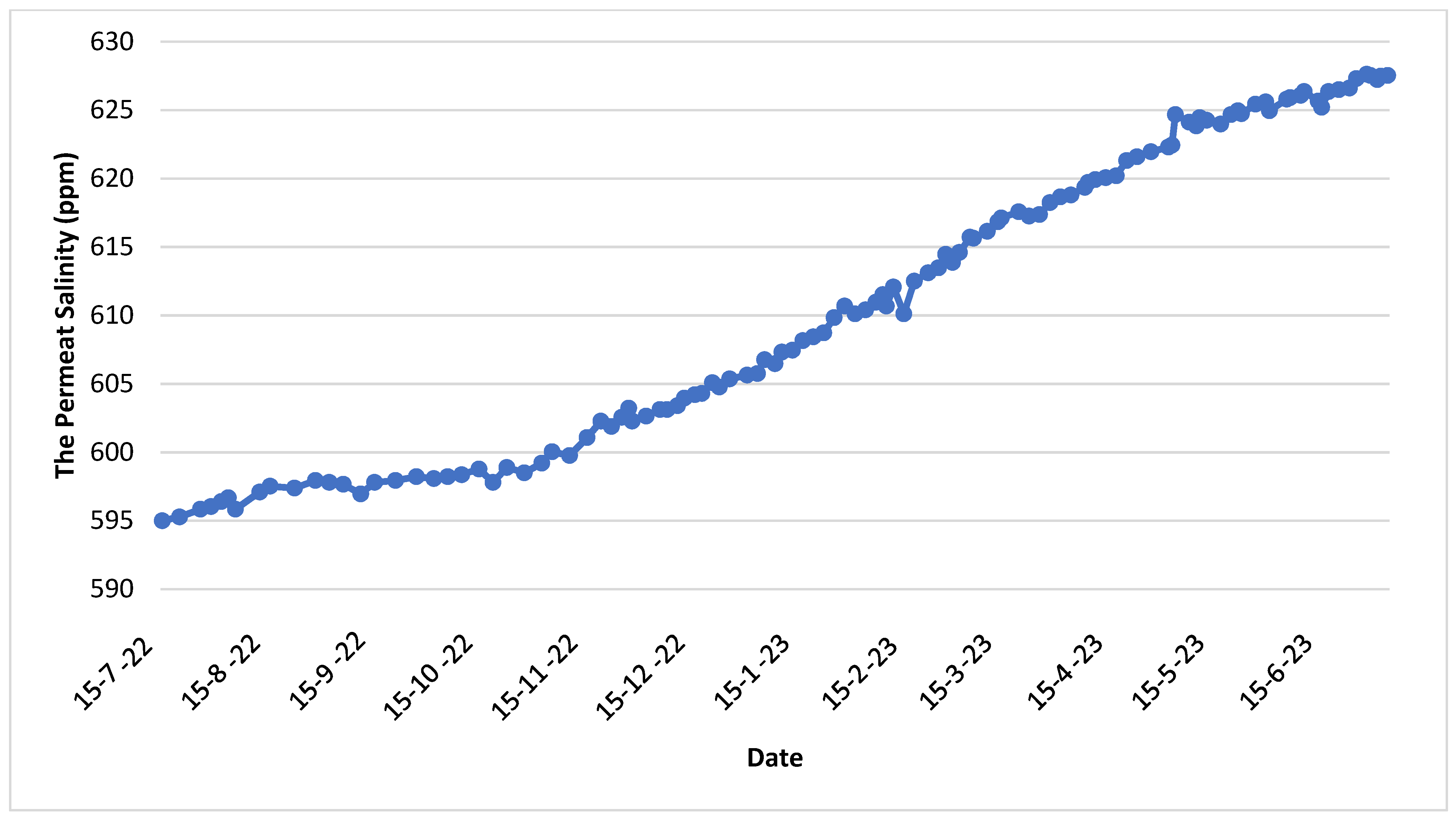
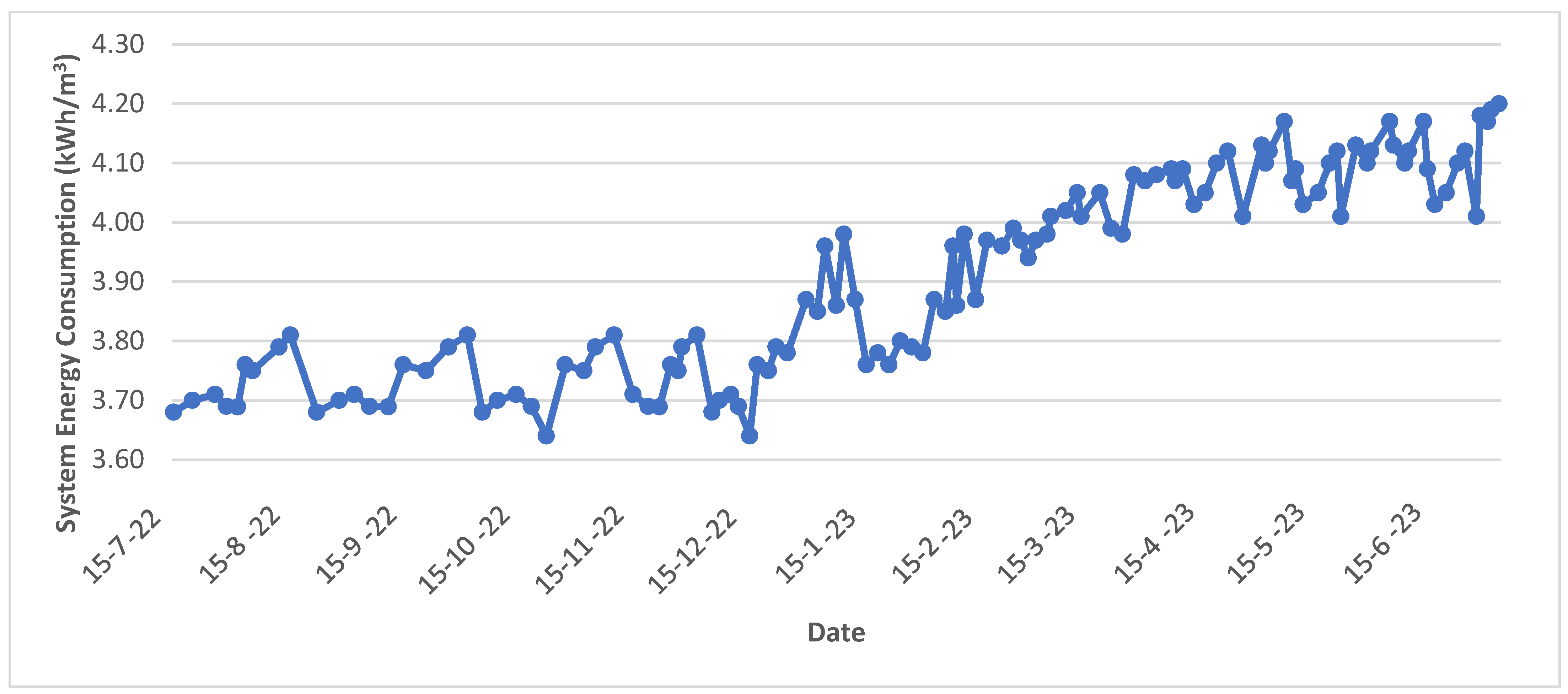
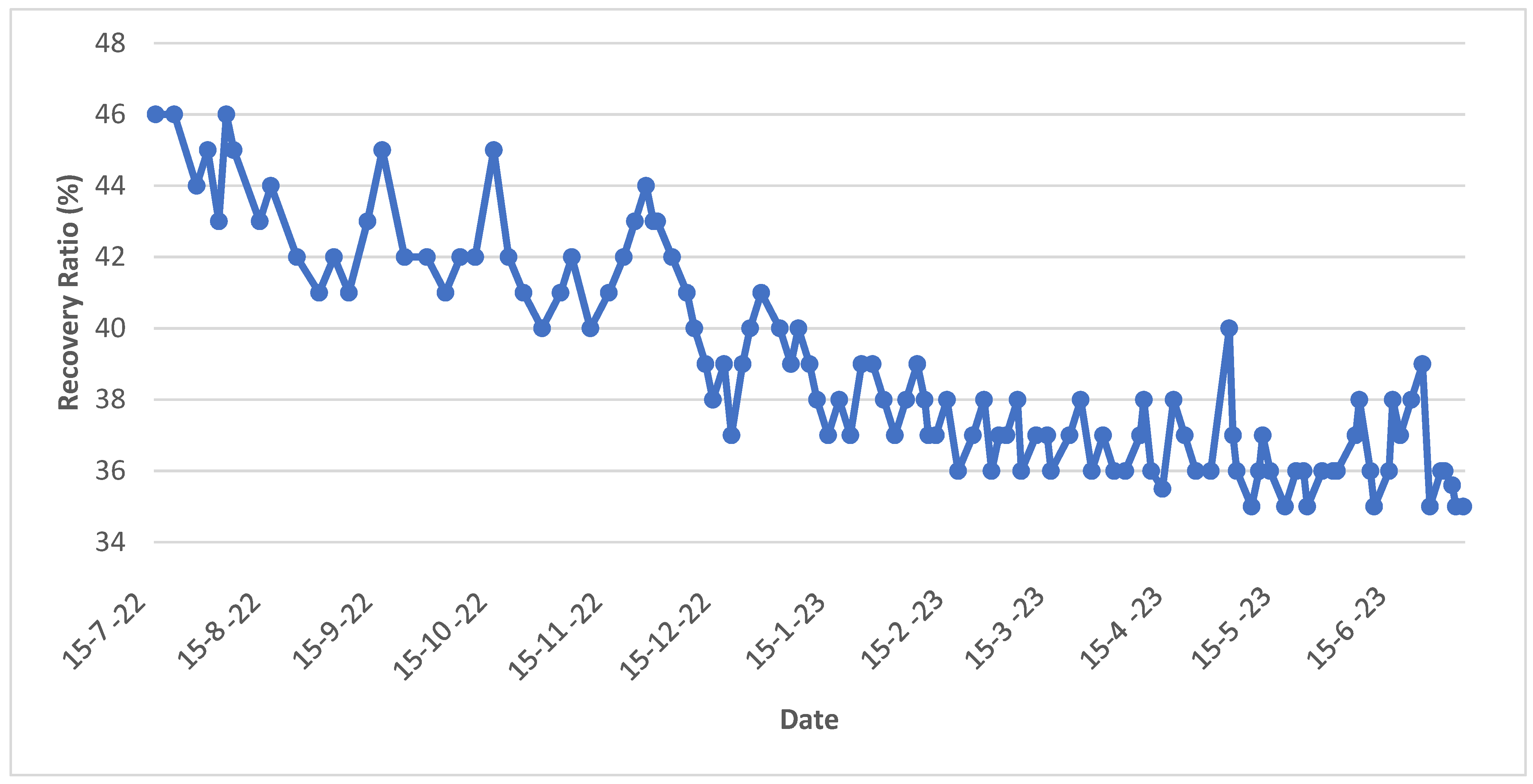
| Category | Water Resource | Water Resources (BCM)—2022 | Water Resources (BCM)—2030 |
|---|---|---|---|
| Renewable water resources | Nile water | 55.50 | 55.50 |
| Renewable groundwater | 3.40 | 6.80 | |
| Rain-fed harvesting | 1.05 | 1.10 | |
| Virtual water | Estimated virtual water | 34.00 | 41 |
| Non-conventional water | Non-renewable groundwater | 2.65 | 3.20 |
| Agriculture drainage reuse | 9.70 | 9.70 | |
| Reuse of treated Wastewater | 4.90 | 5.30 | |
| Desalinated water | 0.25 | 0.46 | |
| Water resources | 114.45 | 123.06 | |
| Water demand | 131.65 | 158.16 | |
| Water resources deficit | 20.2 | 35.1 | |
| Parameter | Measuring Unit | Value |
|---|---|---|
| Salinity (TSD) | mg/L | 21,250 |
| pH | - | 7.7 |
| Temperature | °C | 24.5 |
| Na | mg/L | 7180 |
| K | mg/L | 314 |
| Mg | mg/L | 547 |
| Ca | mg/L | 340 |
| Cl | mg/L | 11,786 |
| HCO3 | mg/L | 543 |
| SO4 | mg/L | 378 |
| NO3 | mg/L | 28 |
| Fe | mg/L | 6 |
| Mn | mg/L | 4 |
| Parameter | Measurement Unit | Value |
|---|---|---|
| Feed water | - | Brackish groundwater using well with a depth of 120 m from the ground level |
| Feed water salinity | mg/L | 21,250 |
| Salt rejection | % | 99.75 |
| Recovery ratio | % | 60 |
| Product flow rate | m3/day | 1000 |
| Produced permeate water salinity | mg/L | 250 |
| No | Item | Cost | |
|---|---|---|---|
| EGP | USD | ||
| 1 | Two groundwater wells including the PV solar system for power supply | 3,490,000 | 241,500 |
| 2 | RO desalination plant and the PV solar system | 12,100,000 | 650,540 |
| 3 | Brine water discharge bond | 730,000 | 39,250 |
| Total | 16,320,000 | 931,290 | |
| Technology | Maturity | Technical Aspects | Economic Aspects |
|---|---|---|---|
| Evaporation ponds | Industrial scale | Groundwater contamination could be risk if the ponds are not designed properly. | Land footprint is high due to the large area requirements. |
| Multistage RO | Industrial scale |
| A cost-effective solution encompasses energy efficiency, capital expenditures (Capex), and operating expenses (Opex). |
| Evaporators and crystallizers | Industrial scale | The constraint on Rw in evaporators is scaling. Further research is needed to devise systems capable of recovering residual heat or steam effectively. |
|
| ZLD | Industrial scale for non-municipal applications |
| Low Capex relative to the brine concentration system. |
Disclaimer/Publisher’s Note: The statements, opinions and data contained in all publications are solely those of the individual author(s) and contributor(s) and not of MDPI and/or the editor(s). MDPI and/or the editor(s) disclaim responsibility for any injury to people or property resulting from any ideas, methods, instructions or products referred to in the content. |
© 2024 by the authors. Licensee MDPI, Basel, Switzerland. This article is an open access article distributed under the terms and conditions of the Creative Commons Attribution (CC BY) license (https://creativecommons.org/licenses/by/4.0/).
Share and Cite
Dawoud, M.A.; Sallam, G.R.; Abdelrahman, M.A.; Emam, M. The Performance and Feasibility of Solar-Powered Desalination for Brackish Groundwater in Egypt. Sustainability 2024, 16, 1630. https://doi.org/10.3390/su16041630
Dawoud MA, Sallam GR, Abdelrahman MA, Emam M. The Performance and Feasibility of Solar-Powered Desalination for Brackish Groundwater in Egypt. Sustainability. 2024; 16(4):1630. https://doi.org/10.3390/su16041630
Chicago/Turabian StyleDawoud, Mohamed A., Ghada R. Sallam, Mohamed A. Abdelrahman, and Mohamed Emam. 2024. "The Performance and Feasibility of Solar-Powered Desalination for Brackish Groundwater in Egypt" Sustainability 16, no. 4: 1630. https://doi.org/10.3390/su16041630
APA StyleDawoud, M. A., Sallam, G. R., Abdelrahman, M. A., & Emam, M. (2024). The Performance and Feasibility of Solar-Powered Desalination for Brackish Groundwater in Egypt. Sustainability, 16(4), 1630. https://doi.org/10.3390/su16041630






